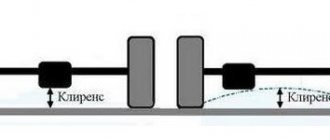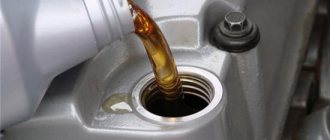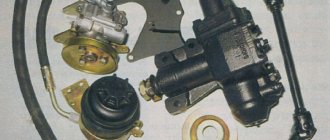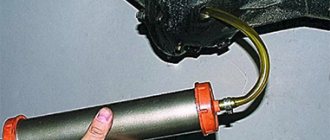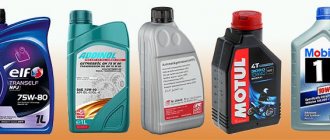21.01.2020
| (Votes: 1, Rating: 5) |
Issues discussed in the material:
- What are the differences between synthetics and semi-synthetics?
- Viscosity characteristics of synthetic and semi-synthetic oils
- Which motor oil is better: synthetic or semi-synthetic?
- Is 5w40 synthetic different from 10w40 semi-synthetic?
- Is it permissible to mix synthetic and semi-synthetic oils?
- Rating winner semi-synthetic motor oil 10w40
- Rating winner synthetic motor oil
“Synthetic or semi-synthetic?” - such a question, along with “spikes or Velcro?” will worry car enthusiasts as long as cars use internal combustion engines and wheels. At first glance, it may seem that synthetic oil is better: it is richer in additives and more expensive. So it's better quality?
In fact, it is impossible to answer this question unequivocally, since, in addition to the lubricant itself, there are other, important factors: manufacturers’ recommendations, the condition of a particular engine, driving style, weather conditions and much more. In our material we will analyze in detail the difference between synthetics and semi-synthetics.
Synthetic or semi-synthetic: what's the difference?
Synthetics
First you need to understand: what is synthetics and what is semi-synthetics. Synthetic oil is an artificially synthesized liquid, the basis of which is still organic substances - natural gas or oil. Various technologies are used for manufacturing, which are discussed in a separate article; here I repeat that the resulting lubricant retains its characteristics throughout the entire period of use, is now considered the most advanced type of lubricants, the molecular formula has been improved, and is resistant to oxidation.
Synthetic oil is supplemented with an additive package that improves fuel combustion and engine power. Synthetics retain viscosity over a wide range of temperatures, in cold weather the engine starts easier, and remains stable under overloads. Provides a stable film on parts in any conditions, has high fluidity. But this type of oil has a significant disadvantage - its high cost, which is why it is used mainly only in new engines that are demanding on the quality of lubricant and are simply dear to their owners. As you know, the newer the thing, the more reverently we treat it. But if we talk about compatibility, then synthetics are better suited for new engines.
Important! To put it bluntly, all oils consist of base oils + a package of additives. Essentially, everything is made from a mineral base. But it is in synthetics that there are more of these additives than base oils. Therefore, the composition is more stable than that of semi-synthetics. And we remember that there are different types of synthetics, hydrocracking (when group 3 base oils are used), PAO synthetics and esters. Shell has its own technology for producing base oil from gas.
Semi-synthetics
This is a mixture of an additive package and mineral oil, but there are many times fewer additives and more mineral oil. At the same time, mineral oil bases come in different classes; in synthetics, as a rule, these classes are higher and cleaner. In semi-synthetics you will not find PAO or Esters. The percentage of content of one or another component is not regulated in any way; depending on the manufacturer, it can be 50x40, 70x30, and so on. Semi-synthetics cannot withstand the same severe frosts as pure synthetics; they always contain fewer additives and are more susceptible to oxidation. That is, it represents a kind of golden mean between expensive synthetics and cheap but ineffective mineral water. Thanks to these properties, semi-synthetics are much more popular, especially for used cars or early years of production.
Important! Choosing synthetics or semi-synthetics is your personal choice. Manufacturers usually indicate in the instructions the viscosity according to SAE in the passport. If, for example, you specify 0w-20, it will be synthetic. And if 10w-40 is semi-synthetic, but even in the 10w-40 class there are synthetics, so you can safely pour synthetics into a VAZ if it’s safer and you consider it necessary.
Decoding the markings of semi-synthetic and synthetic motor oil
All modern manufacturers of motor oils are required to indicate the following information on the canisters with their product: oil type, viscosity grade, quality according to API or GOST classification.
Viscosity is the most basic quality that affects the performance of a lubricant. All motor oils, according to the accepted international classification, are divided into: all-season, winter and summer.
There are two numbers in the designation of all-season oils: the first is an indicator of normal viscosity at subzero temperatures, and the second at positive temperatures. Summer oil is designated by the letters SAE, and winter oil by the letter W.
Winter oil markings:
- 0W – retains all its properties down to -35 degrees;
- 5W – retains all its properties down to -30 degrees;
- 10W – retains all its properties down to -25 degrees;
- 15W – retains all its properties down to -20 degrees;
- 20W – retains all its properties down to –15 degrees.
Summer oil markings:
- SAE 30 – retains all its properties up to +25 degrees;
- SAE 40 – retains all its properties up to +40 degrees;
- SAE 50 – retains all its properties up to +45 degrees;
- SAE 60 – retains all its properties up to +50 degrees or more
API (an abbreviation of the American Petroleum Institute), according to the generally accepted classification, divides oils into the following types:
- S (Service) – oil is suitable for gasoline engines of passenger cars, light-duty vehicles, and minibuses;
- C (Commercial) – this category includes heavy trucks with diesel engines.
For passenger cars with diesel power plants, universal oils designated S/C are suitable.
The letter next to it indicates the characteristics and capabilities of the oil. The closer it is to the end of the alphabet, the better properties this oil will demonstrate.
The markings SC, SD, SE, SF, SG, SH were used to designate oils intended for engines of the 1990s/early 2000s.
SJ and SL – for engines manufactured since 2004;
SM – oil with increased resistance to oxidation, increased protection against wear and deposits, operated at the maximum temperature range;
EC is an abbreviation for Energy Conserving oils for gasoline engines.
If there is a number after the letter, it indicates the type of diesel engine: 2 - two-stroke or 4 - four-stroke.
ACEA classification
According to the classification of the European Association, motor oils are divided into three groups:
- A/B – intended for diesel and gasoline engines of passenger cars and light-duty vehicles;
- C – can be combined with exhaust gas neutralizers;
- E – for diesel engines of heavy trucks.
GOST classification
According to Russian GOST, index 1 indicates oil for gasoline engines, 2 for diesel engines. The next number assigns the viscosity grade.
Fractional codes, for example 63/14, mean that the oil is all-season;
markings 10, 12, 14, 20, 16, 24 - indicate summer oils;
33, 6, 63, 43, 53 – winter oils.
Oil marked 8 is also all-season. The letter “Z” indicates that this oil contains a thickening additive.
In addition, according to GOST, the letter index designates the group of engines for which the use of this engine oil is recommended:
- A – for diesel and gasoline non-boosted engines;
- B – for low-powered engines;
- B – for medium-force;
- G – for highly forced ones;
- D - for highly accelerated engines used in unfavorable or extreme conditions.
For example, the marking M-6з/10В means that this oil is recommended for medium-boost engines, it is all-season, with a thickening additive.
What are the differences and which is better?
The difference is in the molecular composition itself: synthetics have well-thought-out technical characteristics, its molecular formula is special, due to which it becomes resistant to thermal and chemical influences, and the replacement period is extended. Semi-synthetics have a stability higher than mineral water, but less than synthetics, but it is affordable and, in general, performs its functions very well.
What's better? This is a trick question and does not have a simple answer. In terms of technical characteristics, of course, pure synthetics are better. But in general, both types of oil are good: synthetics are ideal for new cars, semi-synthetics for used cars - at what point it’s time to switch to semi-synthetics no one can say for sure, it depends on the engine, its condition and the service life set by the manufacturer. The problem is that in a worn-out internal combustion engine, synthetic oil will begin to burn more, but this does not always happen. In addition, the main role when choosing an oil is not this factor, but the tolerances and specifications of the oil according to international standards; they determine which engines can be filled with a particular lubricant.
My advice! If you have already asked yourself the question of switching from semi-synthetics to synthetics. I advise you to try it, especially in winter this is important. Just fill it up and observe the operation of the engine, the amount of oil used after 1000 miles and a visual assessment of the engine after a mileage of 7000-8000 km. If you notice negative aspects that are unlikely, you can always return to semi-synthetics. Such an experience will not cause damage to the engine.
5W40
The car enthusiasts club will tell you that this viscosity category is in demand, provided that the product is made with high quality and is not counterfeit.
It has the following distinctive characteristics:
- Stabilizes the functioning of the engine, cleans its cavity.
- Reduces wear rate.
- Increases protection against thermal oxidation.
- Prevents rust.
- Increases protection against exposure to negative factors.
- Minimal volatility.
- Low consumption.
- Compatible with materials such as seals.
- Possible combination with catalyst type elements.
- Allows you to start the engine at low outside temperatures.
You may be interested in: Rating of the best anti-gravel for cars: types, scope, reviews
Three types of oil were included in the ranking of the best.
Castrol Edge 5W-40
The average price is 2190 rubles.
Increases the performance and wear resistance of the motor, both modern and old. Created by the best engineers based on innovative materials. Designed for harsh conditions. Can be poured into productive equipment that has high demands.
The composition is made in such a way that it is able to: be used for a long time, suppress the formation of deposits on the walls of the engine, and increase the speed of response to starting.
The product will significantly increase efficiency and protect the engine under various driving conditions, regardless of the outside temperature. Can keep the system in its best condition even with intensive and long-term operation.
Castrol Edge 5W-40
Advantages
- good engine protection;
- resistance to low temperatures;
- improves engine performance.
Flaws
- none.
Total Quartz 9000 5W40
Average price: 500 rubles.
The main purpose is an engine with a turbine or hybrid elements. Therefore, it is permissible to use it in aggressive driving and in difficult atmospheric conditions. All-season. Can be poured into injection mechanisms and cross-type machines. Suitable for foreign cars, domestic vehicles, including objects running on gas and unleaded alcohol. The characteristics indicate the presence of excellent antioxidant qualities and good thermal performance.
Total Quartz 9000 5W4
Advantages
- high level of efficiency;
- increased engine protection during cold starts;
- resistance to low temperatures.
Flaws
- not identified.
Polymerium Xpro 1
Average price: 750 rubles.
The oil was supplied with components that increase resistance to oxidation. Among the advantages are the presence of: reducing friction of elements by almost 30%, increasing fuel efficiency. Additives are made on the basis of microceramics, which significantly reduces the wear rate of the motor and its components. Significant noise reduction is possible. It hardens only at air temperatures below -41°C.
Polymerium Xpro 1
Advantages
- reduces the noise level during internal combustion engine operation;
- reduces fuel consumption;
- profitable price.
Flaws
- freezes at air temperatures less than -40 ° C.
Unfortunately, oil ranked third is often subject to counterfeiting. Therefore, when purchasing, you need to study the original security marks of the brand.
How to distinguish synthetics from semi-synthetics
You can distinguish one type of oil from another by the inscription on the packaging:
- Semi Synthetic - semi-synthetic formulations containing at least 50% synthetic components.
Synthetic based oils:
- Synthetically Fortified – synthetically fortified with synthetic content up to 30%.
- Synthetic Based – synthetics up to 30%.
- Synthetic Technology – synthetics up to 50%.
Synthetic motor oils are labeled Fully Synthetic .
Important! When purchasing an oil, be sure to read its review and study laboratory tests from independent laboratories. Let’s say synthetics in a “hydrocrack” are always inferior to PAO synthetics, but in a canister these data are often kept silent or exaggerated by adding 5-10% PAO to the composition, proudly declaring PAO synthetics. In general, it is useful to study laboratory tests in order to choose the ideal oil for your car.
Individual approach
Selecting oil is a completely individual process. It takes into account the make of the car, its mileage, the condition of the engine, types of fuel (gasoline or diesel), season and operating conditions of the vehicle. There is a general recommendation to change the oil under normal operating conditions after every 10 thousand km, and according to the general opinion of leading automakers that the conditions in Russia are recognized as difficult, it is better to change the oil after 5 thousand km.
For diesel engines, more frequent oil changes may be recommended. We advise you to follow the replacement periods recommended by the manufacturers, since the formation of combustion products does not improve the performance of your car’s engine. The product of Mobil, which belongs to synthetic motor products, is widely known among consumers. This type contains additives that increase the elasticity properties of engine sealing devices, which avoid possible oil leakage.
Hint for selecting lubricant type by temperature range
The use of synthetic motor oils is intended for all types of vehicles, regardless of the region of operation and any load class. Under the most difficult operating conditions, the advantages of synthetic analogues over mineral ones will become increasingly obvious. The assumption about the greater consumption of synthetics, compared to mineral ones, turned out to be erroneous, since waste is the result of the decomposition of the underlying mineral base.
Consequently, the fundamental difference between a mineral and a synthetic product will be the different technology for their production, as a result of which these oils have different properties. Synthetic ones have a more stable molecular network, which makes them more effective under high loads and does not cause slag and varnish deposits. Mineral analogues have a limited period of use and do not allow violations of the replacement period.
General advice for motorists would be the following: you should only purchase a product whose quality is not of concern. It is better to use products from a reputable manufacturer.
How to correctly switch from synthetics to semi-synthetics
You should not change the oil type only based on mileage. The main criterion by which it is determined that it is time to switch to semi-synthetics is increased oil consumption, this means that the wear of engine parts has reached the point at which the less viscous synthetic begins to burn out and needs to be replaced with oil with a slightly higher viscosity.
Another factor is that synthetics have better cleaning properties, remove dirt that acted as a seal in some gaps, resulting in the formation of cracks and this also affects oil consumption. But, of course, you shouldn’t put all the work on the oil alone; you should also trust the engine; perhaps the cause of the leak is not the lubricant at all.
Advice: The formula is simple - if oil consumption does not increase, fill in synthetic and do not pay attention to any advice. Semi-synthetics will not be able to maintain the internal parts of the internal combustion engine as well as in their original form, as synthetics based on hydrocracking, PAO synthetics and esters do. For winter, synthetics are not replaceable; semi-synthetics are simply not a competitor in severe frosts.
Do I need to flush the engine?
When switching from synthetics to semi-synthetics, it is not necessary to flush the engine, but it is better to reduce the new oil mileage interval by half, and subsequent times you can return to the required interval. But if the transition is made in the opposite direction - from semi-synthetics to synthetics, then flushing should be done more preferably, but again, this is not a critical factor.
Is it possible to mix
A small amount of oil remains in the system during filling, so mixing occurs in any case; if you want to protect your engine, use lubricant from one manufacturer. You should not mix synthetics and semi-synthetics; if this happens, it is better to reduce the service interval (when changing the oil) and replace it as quickly as possible if you just had to add semi-synthetics to synthetics. And I remain of the opinion that for this purpose you need to take the same brand, or at least one that is similar in all tolerances and classifications.
5W30
Fueling your car well means purchasing 5W30 synthetic oil. The solution has many advantages. The lubricating fluid is suitable for cars that are used in the city and their engine elements do not have a negative impact.
There are a number of positive properties:
- It is permissible to operate at idle speed without causing any consequences.
- Doesn't get used up when you're stuck in traffic jams frequently.
- Suitable for cars driving short distances.
- Resistance to increased atmospheric dust.
- High protection of the motor cavity from destruction.
- Property – removal of carbon deposits from the surface of elements.
- Anti-corrosion property.
- Cools parts and components inside the engine system.
There are 3 popular product options.
Liqui MOLY Special Tec AA 5W-30
Average price 2000 rub.
Synthetic product with API SN class. Area of application: gasoline and diesel engines. Designed specifically for imported cars, regardless of the country of production.
Helps reduce the noise of the hydraulic compensator and engine operation, and has excellent cleaning properties.
Copes well with reducing fuel consumption, excellently maintains fluidity even in severe frost. Excellent resistance to rust. Prohibited for engines with a mileage of more than 100,000 km and mixing with oils of a different viscosity.
Liqui MOLY Special Tec AA 5W-30
Advantages
- improved engine performance;
- noise reduction;
- resistance to severe frosts.
Flaws
- It is prohibited to use on engines with a mileage of more than 100,000 km.
Zic XQ LS
The average price is 535 rubles.
Perfect for gasoline and diesel engines, especially those with a built-in turbocharging system. Poured into structures where particulate filters and catalytic converters are installed. Copes with a reduction in fuel consumption, increases the wear resistance of this part of the machine, and forms excellent protection for the particulate filter. This is facilitated by the low ash content. Stable performance even at high temperatures. It is not advisable to use it with gasoline of a category lower than E4. This is a motor oil with good cleaning properties.
Zic XQ LS
Advantages
- can be used with a particulate filter;
- preservation of properties even at low air temperatures;
- low ash content.
Flaws
- Use is prohibited when using gasoline below grade E4.
Moly Green Premium Black 5W30
The average price is 1850 rubles.
Synthetic products designed to reduce fuel consumption. Scope of application: gasoline, diesel, four-pin engines, supplemented with turbocharging. The product is created in accordance with international quality standards.
Research has revealed the ability to improve the functioning of a new engine, increase mileage, increase productivity, and ensure safe operation on cold starts.
The additives included in the composition have high resistance properties. The advantage is resistance to temperatures of -42°C.
Moly Green Premium Black 5W30
Advantages
- does not freeze at an air temperature of -42°C;
- safety for internal combustion engines;
- excellent quality.
Flaws
- none.
Since the latter type of oil was created by a Japanese company, it is recommended that it be used on Asian-made machines.
Which oil is better for a used engine?
Depends on engine wear. If there is depletion, then it is better to use a higher viscosity semi-synthetic, but select a product that creates an oil film that is acceptable according to the parameters, that is, within the framework recommended by the manufacturer. If leaks appear, then they begin to use oils with a reinforced additive system that seal the system, protect and renew the seals. If the internal space is very dirty, then it goes without saying that you need to fill in oil with improved cleaning properties, which synthetics have, although semi-synthetic compounds also have good detergent additive packages.
When switching to a thicker product, it is important to stay within the manufacturer's approved range and calculate the SAE by season. If, even after reaching a high mileage (100, 200, 300 thousand) no changes have occurred, then there is no need to change the type of oil. We continue to drive what we used and enjoy life.
Which is better in winter, synthetic or semi-synthetic?
It all depends on the climatic characteristics of the region in which the car will be used and the presence of cold starts. If the temperature in winter drops below -30 and stays at this level for a long time, it is better to use synthetics based on PAO of the appropriate viscosity according to SAE. But don’t forget about the manufacturers’ recommendations and don’t deviate from them. For a temperate climate, the properties of semi-synthetics are quite sufficient.
Answer: For the northern regions, synthetics are better! Preferably on a PJSC basis. Be sure to look at the laboratory tests for the pour point and dynamic viscosity of CSS at -35℃.
Which oil burns more?
Oil consumption for burning depends on the flash point - the higher it is, the less oil will burn. As a rule, synthetics exhibit a higher flash point, which means less waste. But again, we need to make a reservation that this depends on the type and condition of the motor. In older engines where wear is observed, synthetics may begin to burn out, while semi-synthetics will not show this.
Answer: If we take ideal conditions, synthetics burn less, sometimes significantly less. Much depends on the current condition of the engine.
Introduction
There is no need to say for a long time how important motor oil is for the condition of the engine. Without good protection of all joints and cylinder walls, even the highest quality engine will not last long, but the search for a good lubricant constantly causes difficulties and controversy. In addition to the endless number of brands, there is also a breakdown by typology: synthetic or semi-synthetic? Which is preferable to fill into the engine?
This article will help you decide which oil suits your needs best.
Results. Brief answers to all questions.
- What is the difference between synthetics and semi-synthetics? Answer: As base oils and additive packages. Synthetics have premium base oils and a larger additive package, so they are more stable in every sense.
- What's better? Answer: Synthetics are better in all respects. You need to answer the question for yourself, why spend more on synthetics if the car feels great on semi-synthetics? If it makes sense to you, then feel free to move on.
- Is it necessary to flush the engine? Answer: Not necessarily. Optional. You can shorten the first interval to 3000 km and skip the flushing.
- Is it possible to mix? Answer: You can, but it is not necessary. All motor oils are compatible with each other, but no one can give you a guarantee that everything will be smooth after mixing. I advise you not to ride for a long time on such a mixture.
- What's better in winter? Answer: Definitely synthetic. But we remember about expediency; in frosts down to -20, semi-synthetics also work great.



